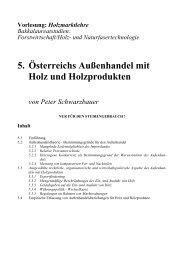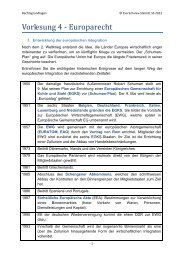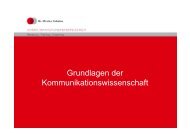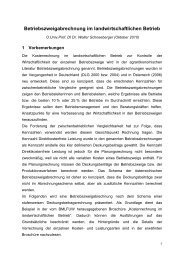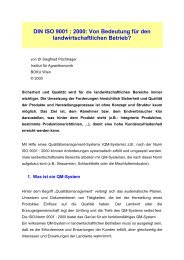Supply Chain Management
Supply Chain Management
Supply Chain Management
Create successful ePaper yourself
Turn your PDF publications into a flip-book with our unique Google optimized e-Paper software.
<strong>Supply</strong> <strong>Chain</strong> <strong>Management</strong><br />
<strong>Supply</strong> <strong>Chain</strong> <strong>Management</strong><br />
Produkt- und Prozessdesign<br />
Informationsverarbeitung<br />
Versorgungssicherheit und Lagerhaltung<br />
Simchi Levi (2005) Managing the <strong>Supply</strong> chain,…<br />
Unternehmensnetzwerke<br />
1
<strong>Supply</strong><br />
Sources:<br />
plants<br />
vendors<br />
ports<br />
Production/<br />
purchase<br />
costs<br />
Regional<br />
Warehouses:<br />
stocking<br />
points<br />
Inventory &<br />
warehousing<br />
costs<br />
Field<br />
Warehouses:<br />
stocking<br />
points<br />
Transportation<br />
costs<br />
Inventory &<br />
warehousing<br />
costs<br />
Unternehmensnetzwerke<br />
Customers,<br />
demand<br />
centers<br />
sinks<br />
Transportation<br />
costs<br />
2
Inventory<br />
Where do we hold inventory?<br />
Suppliers and manufacturers<br />
warehouses and distribution centers<br />
retailers<br />
Types of Inventory<br />
WIP<br />
raw materials<br />
finished goods<br />
Why do we hold inventory?<br />
Economies of scale<br />
Uncertainty in supply and demand<br />
Unternehmensnetzwerke<br />
3
Understanding Inventory<br />
The inventory policy is affected by:<br />
Demand Characteristics<br />
Lead Time<br />
Number of Products<br />
Objectives<br />
Service level<br />
Minimize costs<br />
Cost Structure<br />
Unternehmensnetzwerke<br />
4
Cost Structure<br />
Order costs<br />
Fixed<br />
Variable<br />
Holding Costs<br />
Insurance<br />
Maintenance and Handling<br />
Taxes<br />
Opportunity Costs<br />
Obsolescence<br />
Unternehmensnetzwerke<br />
5
EOQ: A Simple Model*<br />
Book Store Mug Sales<br />
Demand is constant, at 20 units a week<br />
Fixed order cost of $12.00, no lead time<br />
Holding cost of 25% of inventory value annually<br />
Mugs cost $1.00, sell for $5.00<br />
Question<br />
How many, when to order?<br />
Unternehmensnetzwerke<br />
6
EOQ: A View of Inventory*<br />
Note:<br />
• No Stockouts<br />
• Order when no inventory<br />
• Order Size determines policy<br />
Order<br />
Size<br />
Inventory<br />
Unternehmensnetzwerke<br />
Avg. Inven<br />
Time<br />
7
EOQ: Calculating Total Cost*<br />
Purchase Cost Constant<br />
Holding Cost: (Avg. Inven) * (Holding Cost)<br />
Ordering (Setup Cost):<br />
Number of Orders * Order Cost<br />
Goal: Find the Order Quantity that Minimizes These Costs:<br />
Unternehmensnetzwerke<br />
8
EOQ:Total Cost*<br />
Cost<br />
160<br />
140<br />
120<br />
100<br />
80<br />
60<br />
40<br />
20<br />
0<br />
Total Cost<br />
0 500 1000 1500<br />
Order Quantity<br />
Unternehmensnetzwerke<br />
Order Cost<br />
Holding Cost<br />
9
EOQ: Optimal Order Quantity*<br />
Optimal Quantity =<br />
Q= 2∗Demand∗Setup Cost<br />
holding cost<br />
So for our problem, the optimal quantity is 316<br />
Unternehmensnetzwerke<br />
10
EOQ: Important Observations*<br />
Tradeoff between set-up costs and holding costs when determining<br />
order quantity. In fact, we order so that these costs are equal per unit<br />
time<br />
Total Cost is not particularly sensitive to the optimal order quantity<br />
Order Quantity 50% 80% 90% 100% 110% 120% 150% 200%<br />
Cost Increase 125% 103% 101% 100% 101% 102% 108% 125%<br />
Unternehmensnetzwerke<br />
11
The Effect of Demand Uncertainty<br />
Most companies treat the world as if it were predictable:<br />
Production and inventory planning are based on forecasts of demand<br />
made far in advance of the selling season<br />
Companies are aware of demand uncertainty when they create a<br />
forecast, but they design their planning process as if the forecast<br />
truly represents reality<br />
Recent technological advances have increased the level of demand<br />
uncertainty:<br />
Short product life cycles<br />
Increasing product variety<br />
Unternehmensnetzwerke<br />
12
Demand Forecasts<br />
The three principles of all forecasting techniques:<br />
Forecasting is always wrong<br />
The longer the forecast horizon the worst is the forecast<br />
Aggregate forecasts are more accurate<br />
Unternehmensnetzwerke<br />
13
SnowTime Sporting Goods<br />
Fashion items have short life cycles, high variety of competitors<br />
SnowTime Sporting Goods<br />
New designs are completed<br />
One production opportunity<br />
Based on past sales, knowledge of the industry, and economic<br />
conditions, the marketing department has a probabilistic forecast<br />
The forecast averages about 13,000, but there is a chance that<br />
demand will be greater or less than this.<br />
Unternehmensnetzwerke<br />
14
SnowTime Demand Scenarios<br />
Probability<br />
30%<br />
25%<br />
20%<br />
15%<br />
10%<br />
5%<br />
0%<br />
8000<br />
Demand Scenarios<br />
10000<br />
12000<br />
14000<br />
Sales<br />
16000<br />
Unternehmensnetzwerke<br />
18000<br />
15
SnowTime Costs<br />
Production cost per unit (C): $80<br />
Selling price per unit (S): $125<br />
Salvage value per unit (V): $20<br />
Fixed production cost (F): $100,000<br />
Q is production quantity, D demand<br />
Profit =<br />
Revenue - Variable Cost - Fixed Cost + Salvage<br />
Unternehmensnetzwerke<br />
16
SnowTime Scenarios<br />
Scenario One:<br />
Suppose you make 12,000 jackets and demand ends up being<br />
13,000 jackets.<br />
Profit = 125(12,000) - 80(12,000) - 100,000 = $440,000<br />
Scenario Two:<br />
Suppose you make 12,000 jackets and demand ends up being<br />
11,000 jackets.<br />
Profit = 125(11,000) - 80(12,000) - 100,000 + 20(1000) = $ 335,000<br />
Unternehmensnetzwerke<br />
17
SnowTime Best Solution<br />
Find order quantity that maximizes weighted average profit.<br />
Question: Will this quantity be less than, equal to, or greater than<br />
average demand?<br />
Unternehmensnetzwerke<br />
18
What to Make?<br />
Question: Will this quantity be less than, equal to, or greater than<br />
average demand?<br />
Average demand is 13,100<br />
Look at marginal cost Vs. marginal profit<br />
if extra jacket sold, profit is 125-80 = 45<br />
if not sold, cost is 80-20 = 60<br />
So we will make less than average<br />
Optimal quantity?<br />
<br />
Unternehmensnetzwerke<br />
19
SnowTime Expected Profit<br />
Profit<br />
$400,000<br />
$300,000<br />
$200,000<br />
$100,000<br />
Expected Profit<br />
$0<br />
8000 12000 16000 20000<br />
Order Quantity<br />
Unternehmensnetzwerke<br />
20
SnowTime Expected Profit<br />
Profit<br />
$400,000<br />
$300,000<br />
$200,000<br />
$100,000<br />
Expected Profit<br />
$0<br />
8000 12000 16000 20000<br />
Order Quantity<br />
Unternehmensnetzwerke<br />
21
SnowTime Expected Profit<br />
Profit<br />
$400,000<br />
$300,000<br />
$200,000<br />
$100,000<br />
Expected Profit<br />
$0<br />
8000 12000 16000 20000<br />
Order Quantity<br />
Unternehmensnetzwerke<br />
22
SnowTime:<br />
Important Observations<br />
Tradeoff between ordering enough to meet demand and ordering too<br />
much<br />
Several quantities have the same average profit<br />
Average profit does not tell the whole story<br />
Question: 9000 and 16000 units<br />
lead to about the same average<br />
profit, so which do we prefer?<br />
Unternehmensnetzwerke<br />
23
Probability of Outcomes<br />
Probability<br />
100%<br />
80%<br />
60%<br />
40%<br />
20%<br />
0%<br />
-300000<br />
-100000<br />
100000<br />
300000<br />
Cost<br />
500000<br />
Unternehmensnetzwerke<br />
Q=9000<br />
Q=16000<br />
24
Key Points from this Model<br />
The optimal order quantity is not necessarily equal to average<br />
forecast demand<br />
The optimal quantity depends on the relationship between marginal<br />
profit and marginal cost<br />
As order quantity increases, average profit first increases and then<br />
decreases<br />
As production quantity increases, risk increases. In other words, the<br />
probability of large gains and of large losses increases<br />
Unternehmensnetzwerke<br />
25
Initial Inventory<br />
Suppose that one of the jacket designs is a model produced last year.<br />
Some inventory is left from last year<br />
Assume the same demand pattern as before<br />
If only old inventory is sold, no setup cost<br />
Question: If there are 7000 units remaining, what should SnowTime do?<br />
What should they do if there are 10,000 remaining?<br />
Unternehmensnetzwerke<br />
26
Initial Inventory and Profit<br />
Profit<br />
500000<br />
400000<br />
300000<br />
200000<br />
100000<br />
0<br />
5000<br />
6500<br />
8000<br />
9500<br />
11000<br />
12500<br />
Unternehmensnetzwerke<br />
14000<br />
Production Quantity<br />
15500<br />
27
Initial Inventory and Profit<br />
Profit<br />
500000<br />
400000<br />
300000<br />
200000<br />
100000<br />
0<br />
5000<br />
6500<br />
8000<br />
9500<br />
11000<br />
12500<br />
14000<br />
Production Quantity<br />
Unternehmensnetzwerke<br />
15500<br />
28
Initial Inventory and Profit<br />
Profit<br />
500000<br />
400000<br />
300000<br />
200000<br />
100000<br />
0<br />
5000<br />
6500<br />
8000<br />
9500<br />
11000<br />
12500<br />
14000<br />
Production Quantity<br />
Unternehmensnetzwerke<br />
15500<br />
29
Initial Inventory and Profit<br />
Profit<br />
500000<br />
400000<br />
300000<br />
200000<br />
100000<br />
0<br />
5000<br />
6000<br />
7000<br />
8000<br />
9000<br />
10000<br />
11000<br />
12000<br />
13000<br />
14000<br />
Production Quantity<br />
Unternehmensnetzwerke<br />
15000<br />
16000<br />
30
(s, S) Policies<br />
For some starting inventory levels, it is better not to start production<br />
If we start, we always produce to the same level<br />
Thus, we use an (s,S) policy. If the inventory level is below s, we<br />
produce up to S.<br />
s is the reorder point, and S is the order-up-to level<br />
The difference between the two levels is driven by the fixed costs<br />
associated with ordering, transportation, or manufacturing<br />
Unternehmensnetzwerke<br />
31
A Multi-Period Inventory Model<br />
Often, there are multiple reorder opportunities<br />
Consider a central distribution facility which orders from a manufacturer<br />
and delivers to retailers. The distributor periodically places orders to<br />
replenish its inventory<br />
Unternehmensnetzwerke<br />
32
Case Study: Electronic Component Distributor<br />
Electronic Component Distributor<br />
Parent company HQ in Japan with world-wide manufacturing<br />
All products manufactured by parent company<br />
One central warehouse in U.S.<br />
Unternehmensnetzwerke<br />
33
Case Study:The <strong>Supply</strong> <strong>Chain</strong><br />
Unternehmensnetzwerke<br />
34
Demand Variability: Example 1<br />
Demand<br />
(000's)<br />
250<br />
200<br />
150<br />
100<br />
50<br />
0<br />
Apr<br />
150<br />
75<br />
Jun<br />
Product Demand<br />
225<br />
150<br />
100<br />
Aug<br />
50<br />
Oct<br />
125<br />
Month<br />
Unternehmensnetzwerke<br />
61 48 53<br />
Dec<br />
Feb<br />
104<br />
45<br />
35
Demand Variability: Example 1<br />
Frequency<br />
25<br />
20<br />
15<br />
10<br />
5<br />
0<br />
$25,000<br />
Histogram for Value of Orders Placed in a Week<br />
$50,000<br />
$75,000<br />
$100,000<br />
$125,000<br />
Unternehmensnetzwerke<br />
$150,000<br />
Value of Orders Placed in a Week<br />
$175,000<br />
$200,000<br />
36
Reminder:<br />
The Normal Distribution<br />
Standard Deviation = 10<br />
Average = 30<br />
0 10 20 30 40 50 60<br />
Unternehmensnetzwerke<br />
Standard Deviation = 5<br />
37
The distributor holds inventory to:<br />
Satisfy demand during lead time<br />
Protect against demand uncertainty<br />
Balance fixed costs and holding costs<br />
Unternehmensnetzwerke<br />
38
The Multi-Period Inventory Model<br />
Normally distributed random demand<br />
Fixed order cost plus a cost proportional to amount ordered.<br />
Inventory cost is charged per item per unit time<br />
If an order arrives and there is no inventory, the order is lost<br />
The distributor has a required service level. This is expressed as the the<br />
likelihood that the distributor will not stock out during lead time.<br />
Intuitively, what will a good policy look like?<br />
Unternehmensnetzwerke<br />
39
A View of (s, S) Policy<br />
Inventory Level<br />
S<br />
s<br />
0<br />
Lead<br />
Time<br />
Inventory Position<br />
Unternehmensnetzwerke<br />
Time<br />
40
The (s,S) Policy<br />
(s, S) Policy: Whenever the inventory position drops below a certain<br />
level, s, we order to raise the inventory position to level S.<br />
The reorder point is a function of:<br />
The Lead Time<br />
Average demand<br />
Demand variability<br />
Service level<br />
Unternehmensnetzwerke<br />
41
Notation<br />
AVG = average daily demand<br />
STD = standard deviation of daily demand<br />
LT = replenishment lead time in days<br />
h = holding cost of one unit for one day<br />
SL = service level (for example, 95%). This implies that the probability of<br />
stocking out is 100%-SL (for example, 5%)<br />
Also, the Inventory Position at any time is the actual inventory plus<br />
items already ordered, but not yet delivered.<br />
Unternehmensnetzwerke<br />
42
Analysis<br />
The reorder point has two components:<br />
To account for average demand during lead time:<br />
LT×AVG<br />
To account for deviations from average (we call this safety stock)<br />
z *STD * LT<br />
where z is chosen from statistical tables to ensure that the probability<br />
of stockouts during leadtime is 100%-SL.<br />
Popular z-values??<br />
0.95<br />
0.99<br />
Unternehmensnetzwerke<br />
43
Example<br />
The distributor has historically observed weekly demand of:<br />
AVG = 44.6 STD = 32.1<br />
Replenishment lead time is 2 weeks, and desired service level SL = 97%<br />
Average demand during lead time is:<br />
44.6 × 2 = 89.2<br />
Safety Stock is:<br />
1.88 × 32.1 × 2<br />
= 85.3<br />
Reorder point is thus 175, or about 3.9 weeks of supply at warehouse<br />
and in the pipeline<br />
Unternehmensnetzwerke<br />
44
Safety Stocks for HP Deskjet<br />
Unternehmensnetzwerke<br />
45
Model Two:<br />
Fixed Costs*<br />
In addition to previous costs, a fixed cost K is paid every time an order is<br />
placed.<br />
We have seen that this motivates an (s,S) policy, where reorder point<br />
and order quantity are different.<br />
The reorder point will be the same as the previous model, in order to<br />
meet meet the service requirement:<br />
s = LT * AVG + z * AVG * L<br />
<br />
What about the order up to level?<br />
Unternehmensnetzwerke<br />
46
Model Two:<br />
The Order-Up-To Level*<br />
We have used the EOQ model to balance fixed, variable costs:<br />
<br />
<br />
If there was no variability in demand, we would order Q when inventory<br />
level was at LT×AVG. Why?<br />
There is variability, so we need safety stock<br />
<br />
Q= 2*K*AVG<br />
h<br />
z * AVG * LT<br />
The total order-up-to level is:<br />
S=max{Q, AVG * LT} + z * AVG * LT<br />
Unternehmensnetzwerke<br />
47
Model Two: Example*<br />
Consider the previous example, but with the following additional info:<br />
fixed cost of $4500 when an order is placed<br />
$250 product cost<br />
holding cost 18% of product<br />
Weekly holding cost:<br />
h = (.18 × 250) / 52 = 0.87<br />
Order quantity<br />
Q = 2∗4500∗44.6/0.87=679<br />
Order-up-to level:<br />
safety stock + Q = 85 + 679 = 765<br />
Unternehmensnetzwerke<br />
48
Risk Pooling<br />
Consider these two systems:<br />
Supplier<br />
Supplier<br />
Warehouse One<br />
Warehouse Two<br />
Warehouse<br />
Unternehmensnetzwerke<br />
Market One<br />
Market Two<br />
Market One<br />
Market Two<br />
49
Risk Pooling<br />
For the same service level, which system will require more inventory?<br />
Why?<br />
For the same total inventory level, which system will have better service?<br />
Why?<br />
What are the factors that affect these answers?<br />
Unternehmensnetzwerke<br />
50
Risk Pooling Example<br />
Compare the two systems:<br />
two products<br />
maintain 97% service level<br />
$60 order cost<br />
$.27 weekly holding cost<br />
$1.05 transportation cost per unit in decentralized system, $1.10 in<br />
centralized system<br />
1 week lead time<br />
Unternehmensnetzwerke<br />
51
Risk Pooling Example<br />
Week 1 2 3 4 5 6 7 8<br />
Prod A,<br />
Market 1<br />
Prod A,<br />
Market 2<br />
Prod B,<br />
Market 1<br />
Product B,<br />
Market 2<br />
33 45 37 38 55 30 18 58<br />
46 35 41 40 26 48 18 55<br />
0 2 3 0 0 1 3 0<br />
2 4 0 0 3 1 0 0<br />
Unternehmensnetzwerke<br />
52
Risk Pooling Example<br />
Warehouse Product AVG STD CV<br />
Market 1 A 39.3 13.2 .34<br />
Market 2 A 38.6 12.0 .31<br />
Market 1 B 1.125 1.36 1.21<br />
Market 2 B 1.25 1.58 1.26<br />
Unternehmensnetzwerke<br />
53
Risk Pooling Example<br />
Warehouse Product AVG STD CV s S Avg.<br />
Inven.<br />
Market 1 A 39.3 13.2 .34 65 158 91<br />
Market 2 A 38.6 12.0 .31 62 154 88<br />
Market 1 B 1.125 1.36 1.21 4 26 15<br />
Market 2 B 1.25 1.58 1.26 5 27 15<br />
Unternehmensnetzwerke<br />
%<br />
Dec.<br />
Cent. A 77.9 20.7 .27 118 226 132 26%<br />
Cent B 2.375 1.9 .81 6 37 20 33%<br />
54
Risk Pooling:<br />
Important Observations<br />
Centralizing inventory control reduces both safety stock and average<br />
inventory level for the same service level.<br />
This works best for<br />
High coefficient of variation, which reduces required safety stock.<br />
Negatively correlated demand. Why?<br />
What other kinds of risk pooling will we see?<br />
Unternehmensnetzwerke<br />
55
Risk Pooling:<br />
Types of Risk Pooling*<br />
Risk Pooling Across Markets<br />
Risk Pooling Across Products<br />
Risk Pooling Across Time<br />
Daily order up to quantity is:<br />
LT×AVG + z × AVG × √LT<br />
Orders<br />
10 11 12 13 14 15<br />
Unternehmensnetzwerke<br />
Demands<br />
56
To Centralize or not to Centralize<br />
What is the effect on:<br />
Safety stock?<br />
Service level?<br />
Overhead?<br />
Lead time?<br />
Transportation Costs?<br />
Unternehmensnetzwerke<br />
57
Centralized Systems*<br />
Centralized Decision<br />
Supplier<br />
Warehouse<br />
Unternehmensnetzwerke<br />
Retailers<br />
58
Centralized Distribution Systems*<br />
Question: How much inventory should management keep at each<br />
location?<br />
A good strategy:<br />
The retailer raises inventory to level S r each period<br />
The supplier raises the sum of inventory in the retailer and<br />
supplier warehouses and in transit to S s<br />
If there is not enough inventory in the warehouse to meet all<br />
demands from retailers, it is allocated so that the service level at<br />
each of the retailers will be equal.<br />
Unternehmensnetzwerke<br />
59
The Value of Information<br />
Information age: potential availability of more information<br />
throughout the supply chain<br />
in modern supply chains, information replaces inventory<br />
customers needs products not just information<br />
how can information affect the design and operation of<br />
supply chains?<br />
Unternehmensnetzwerke<br />
60
The Value of Information<br />
Information<br />
helps reduce variability in the SC<br />
helps suppliers make better forecasts<br />
enables the coordination of manufacturing and distribution<br />
systems<br />
enables retailes for locating desired items<br />
enables retailers to react more rapidly<br />
enables lead time reductions<br />
Unternehmensnetzwerke<br />
61
The Value of Information -<br />
The Bullwhip Effect<br />
Observation: while customer<br />
demand for specific products does<br />
not vary much, inventory and backorder<br />
levels fluctuate considerably<br />
across their supply chains<br />
ORDER LT<br />
ORDER LT<br />
ORDER LT<br />
Unternehmensnetzwerke<br />
EXTERNAL DEMAND<br />
RETAILER<br />
WHOLESALER<br />
ORDER LT<br />
DISTRIBUTOR<br />
FACTORY<br />
DELIVERY LT<br />
DELIVERY LT<br />
DELIVERY LT<br />
DELIVERY LT<br />
62
The Bullwhip Effect<br />
Demand<br />
70<br />
60<br />
50<br />
40<br />
30<br />
20<br />
10<br />
0<br />
Order Variations<br />
1 5 9 13 17 21 25 29 33 37 41 45<br />
Period<br />
Unternehmensnetzwerke<br />
Sales<br />
Orders<br />
63
The Value of Information -<br />
The Bullwhip Effect<br />
Main factors contributing to the increase in variability<br />
Demand forecasting<br />
forecasting and inventory control (min-max)<br />
Lead Time<br />
with long lead times a small change in the estimate of demand variability<br />
implies a significant change in in safety stock<br />
why?<br />
Batch Ordering<br />
distorted high variable pattern of orders (min-max)<br />
transportation discounts<br />
sales quotas<br />
Unternehmensnetzwerke<br />
64
The Value of Information -<br />
The Bullwhip Effect<br />
Price fluctuations<br />
stock up<br />
Inflated Orders<br />
shortage periods<br />
Unternehmensnetzwerke<br />
65
<strong>Supply</strong> <strong>Chain</strong> <strong>Management</strong><br />
(Christopher, 1992, S.173): nicht koordinierte Bestellungen<br />
Unternehmensnetzwerke<br />
66
<strong>Supply</strong> <strong>Chain</strong> <strong>Management</strong><br />
Unternehmensnetzwerke<br />
67
The Value of Information -<br />
The Bullwhip Effect<br />
Methods for Coping with the Bullwhip Effect<br />
Reducing Uncertainty<br />
Reducing Variability<br />
Every Day Low Pricing<br />
Lead Time Reduction<br />
Order Lead Time<br />
Information Lead Time<br />
Strategic Partnership<br />
VMI<br />
Unternehmensnetzwerke<br />
68
Bullwhip Reduktion:<br />
Erklärungszugänge<br />
Varianz Reduktion<br />
Schock<br />
Filter<br />
Unternehmensnetzwerke<br />
69
The Value of Information -<br />
The Bullwhip Effect<br />
Effective Forecasts<br />
Cooperative Forecasts systems<br />
CPFR “Collaborative planning, forecasting and<br />
replenishment systems”<br />
Information for the coordination of systems<br />
consider the entire system and coordinate decisions<br />
POS data<br />
need for cooperation<br />
who will optimize???<br />
How will the savings be split between the different<br />
supply chain facilities<br />
Locating desired Products<br />
Unternehmensnetzwerke<br />
70
The Value of Information -<br />
The Bullwhip Effect<br />
Lead Time Reduction<br />
ability to quickly fill customer orders<br />
reduction in the bullwhip effect<br />
more accurate forecasts<br />
reduction in finished goods inventory<br />
Unternehmensnetzwerke<br />
71
Strategic Partnering<br />
Quick Response: Vendors receive POS data from retailers, and use this<br />
information to synchronize production and inventory activities at the supplier. In this<br />
strategy, the retailer still prepares individual orders, but the POS data is used by<br />
the supplier to improve forecasting and scheduling.<br />
Continuous Replenishment: Vendors receive POS data and use it prepare<br />
shipments at previously agreed upon intervals to maintain agreed to levels of<br />
inventory.<br />
Advanced Continuous Replenishment: Suppliers may gradually decrease<br />
inventory levels at the retailer’s store or distribution center as long as service levels<br />
are met. Inventory levels are thus continuously improved in a structured way.<br />
Vendor Managed Inventory (VMI):JITD<br />
Unternehmensnetzwerke<br />
72
Requirements for Effective SP<br />
Advanced information systems<br />
Top management commitment<br />
Mutual trust<br />
Unternehmensnetzwerke<br />
73
Important SP Issues<br />
Inventory ownership:<br />
Supplier owns the goods until they are sold<br />
Retailer owns the goods<br />
Performance measures: Fill rate, inventory level, inventory turns<br />
Unternehmensnetzwerke<br />
74
Important SP Issues<br />
Confidentiality<br />
Communication and cooperation<br />
When First Brands started partnering with Kmart, Kmart often<br />
claimed that its supplier was not living up to its agreement to<br />
keep two weeks of inventory at all times. It turned out that this<br />
was due to the fact that the two companies employed different<br />
forecasting methods.<br />
Unternehmensnetzwerke<br />
75
Steps in SP Implementation<br />
Contractual negotiations<br />
Ownership<br />
Credit terms<br />
Ordering decisions<br />
Performance measures<br />
Develop or integrate information systems<br />
Develop effective forecasting techniques<br />
Develop a tactical decision support tool to assist in coordinating inventory management<br />
and transportation policies<br />
Unternehmensnetzwerke<br />
76
Case Study: Barilla SpA<br />
1) Barilla SpA Part A<br />
2) Barilla SpA Parts B, C and D<br />
3) Strategic Partnership<br />
Reading:<br />
1. Barilla SpA, Harvard Business School, 9-694-046<br />
Unternehmensnetzwerke<br />
77
Barilla SpA Part A<br />
Barilla SpA is the world’s largest pasta manufacturer<br />
The company sells to a wide range of Italian retailers, primarily through third party distributors<br />
During the late 1980s, Barilla suffered increasing operational inefficiencies and cost penalties that<br />
resulted from large week-to-week variations in its distributors’ order patterns<br />
Unternehmensnetzwerke<br />
78
Unternehmensnetzwerke<br />
79
Exhibit 12 Weekly Demand for Barilla Dry Products from Cortese’s Northeast Distribution Center to the<br />
Pedrignano CDC, 1989.<br />
Unternehmensnetzwerke<br />
80
• What exactly is causing the distributor’s order<br />
pattern to look this way?<br />
• What are the underlying drivers of the<br />
fluctuations?<br />
Unternehmensnetzwerke<br />
81
Causes for Demand Fluctuations<br />
Transportation discounts<br />
Volume discount<br />
Promotional activity<br />
No minimum or maximum order quantities<br />
Product proliferation<br />
Long order lead times<br />
Poor customer service rates<br />
Poor communication<br />
Unternehmensnetzwerke<br />
82
Demand Fluctuations<br />
The extreme fluctuation in Exhibit 12 is truly remarkable when one considers the underlying<br />
aggregate demand for pasta in Italy.<br />
What does the underlying consumer demand pattern for pasta look like in Italy?<br />
Unternehmensnetzwerke<br />
83
Demand Fluctuations<br />
What are the differences and similarities between the Barilla channel and the beer distribution<br />
channel?<br />
Unternehmensnetzwerke<br />
84
What is the impact of demand fluctuation seen in Exhibit 12?<br />
Because the plant has high product change over costs, Barilla has either inefficient<br />
production or excess finished goods inventory<br />
Utilization of central distribution is low<br />
Workers<br />
Equipment<br />
Transportation costs are higher than necessary<br />
Unternehmensnetzwerke<br />
85
What is the impact of demand fluctuation seen in Exhibit 12?<br />
The distributor must build excess capacity to hold goods bought on any type of<br />
promotion, including quantity discounts, truckload discounts and canvass period<br />
discounts<br />
What if the distributor passes the discount along to the retailers?<br />
What is the value of the promotion game?<br />
Unternehmensnetzwerke<br />
86
Barilla SpA Part A (continued)<br />
To address this problem, the director of logistics suggests the implementation of Just-in-Time<br />
Distribution (JITD), with Barilla’s distributors.<br />
Under the proposed JITD system, decision-making authority for determining shipments from<br />
Barilla to a distributor would transfer from the distributor to Barilla.<br />
Specifically, rather than simply filling orders specified by the distributor, Barilla would monitor<br />
the flow of its product through the distributor’s warehouse, and then decide what to ship to the<br />
distributor and when to ship it.<br />
Unternehmensnetzwerke<br />
87
Evaluation of the JITD Proposal<br />
Clearly the variation in demand is imposing additional costs on the channel. What do you think of<br />
the JITD proposal as a mechanism for reducing these costs?<br />
Why should this work?<br />
How does it work?<br />
What makes Barilla think that it can do a better job of determining a good product/delivery<br />
sequence than its distributors?<br />
Unternehmensnetzwerke<br />
88
Two Key Concepts Behind JITD<br />
Replace Sequential optimization with Joint optimization<br />
Who will optimize?<br />
Eliminate some of the ‘false’ economics that drive traditional ordering processes<br />
Unternehmensnetzwerke<br />
89
Implementation Issues<br />
Resistance from the Distributors<br />
“Managing stock is my job; I don’t need you to see my warehouse or my figures.”<br />
“I could improve my inventory and service level myself if you would deliver my orders more<br />
quickly; I would place my order and you would deliver within 36 hours.”<br />
“We would be giving Barilla the power to push products into our warehouse just so that Barilla<br />
can reduce its costs.”<br />
?<br />
Unternehmensnetzwerke<br />
90
Implementation Issues<br />
Resistance from Sales and Marketing<br />
“Our sales levels would flatten if we put this program in place.”<br />
“How can we get the trade to push Barilla product to retailers if we don’t offer some sort of<br />
incentive?”<br />
“If space is freed up in our distributors’ warehouses…the distributors would then push our<br />
competitors’ product more than ours.”<br />
“…the distribution organization is not yet ready to handle such a sophisticated relationship.”<br />
?<br />
Unternehmensnetzwerke<br />
91
How Can Maggiali<br />
Solve the Implementation Problems?<br />
Demonstrate that JITD benefits the distributors (lowering inventory, improving their service levels<br />
and increasing their returns on assets); Run experiment at one or more of Barilla’s 18 depots<br />
Maggiali needs to look at JITD not as a logistics program, but as a company-wide effort; Get top<br />
management closely involved<br />
Trust<br />
Unternehmensnetzwerke<br />
92
Barilla (B) Case<br />
What did Barilla learn from the experiments in Florence and Milan?<br />
How should Barilla change the way it attempts to sell the JITD concept to its distributors?<br />
If you were a Barilla distributor, would you sign onto the program after seeing these results?<br />
Unternehmensnetzwerke<br />
93
Unternehmensnetzwerke<br />
94
Unternehmensnetzwerke<br />
95
Unternehmensnetzwerke<br />
96
Unternehmensnetzwerke<br />
97
How do you evaluate the implementation process Barilla used with Cortese?<br />
Unternehmensnetzwerke<br />
98
<strong>Supply</strong> <strong>Chain</strong> <strong>Management</strong><br />
- Vertragsdesign<br />
Lieferant nennt zuerst den Preis und der Händler entscheidet über<br />
die Menge,die er zum Verkauf übernimmt.<br />
Händler kann Menge q ≥<br />
p(<br />
q)<br />
≥<br />
Lieferant hat Herstellkosten<br />
von<br />
zum Preis w<br />
0 zu einem Preis<br />
0 verkaufen,<br />
maximale Menge : q : p(<br />
q)<br />
= 0<br />
c ≤<br />
p(<br />
0)<br />
und verkauft<br />
Ziel: maximiere Gewinn der Wertschöpfungskette<br />
•Gewinn der gesamten Kette<br />
•isolierte Betrachtung<br />
Unternehmensnetzwerke<br />
∧<br />
∧<br />
99
100<br />
Unternehmensnetzwerke<br />
<strong>Supply</strong> <strong>Chain</strong> <strong>Management</strong><br />
Kette<br />
gesamte<br />
die<br />
für<br />
Menge<br />
optimale<br />
0<br />
)<br />
(<br />
)<br />
(<br />
)<br />
)<br />
(<br />
(<br />
)<br />
(<br />
)<br />
(<br />
)<br />
)<br />
(<br />
(<br />
)<br />
(<br />
)<br />
(<br />
)<br />
(<br />
)<br />
(<br />
0<br />
0<br />
'<br />
0<br />
0<br />
<br />
q<br />
q<br />
p<br />
q<br />
c<br />
q<br />
p<br />
c<br />
q<br />
p<br />
q<br />
q<br />
c<br />
w<br />
q<br />
w<br />
q<br />
p<br />
q<br />
q<br />
q<br />
q<br />
q s<br />
r<br />
=<br />
+<br />
−<br />
−<br />
=<br />
Π<br />
−<br />
+<br />
−<br />
=<br />
Π<br />
Π<br />
+<br />
Π<br />
=<br />
Π
101<br />
Unternehmensnetzwerke<br />
<strong>Supply</strong> <strong>Chain</strong> <strong>Management</strong><br />
*<br />
0<br />
0<br />
'<br />
0<br />
0<br />
*<br />
*<br />
'<br />
*<br />
*<br />
0<br />
)<br />
(<br />
)<br />
(<br />
:<br />
Händler<br />
den<br />
für<br />
g<br />
Betrachtun<br />
isolierter<br />
bei<br />
Menge<br />
optimale<br />
0<br />
)<br />
(<br />
)<br />
(<br />
)<br />
)<br />
(<br />
(<br />
)<br />
(<br />
:<br />
Händler<br />
q<br />
q<br />
q<br />
p<br />
q<br />
w<br />
q<br />
p<br />
c<br />
w<br />
q<br />
q<br />
p<br />
q<br />
w<br />
q<br />
p<br />
w<br />
q<br />
p<br />
q<br />
q<br />
r<br />
><br />
<<br />
+<br />
−<br />
><br />
=<br />
+<br />
−<br />
−<br />
=<br />
Π
102<br />
Unternehmensnetzwerke<br />
<strong>Supply</strong> <strong>Chain</strong> <strong>Management</strong><br />
Beispiel:<br />
24<br />
;<br />
8<br />
32<br />
3<br />
8<br />
5)<br />
-<br />
(6<br />
8<br />
(8)<br />
8<br />
q<br />
0<br />
q/2<br />
-<br />
2<br />
-<br />
q/2<br />
-<br />
10<br />
:<br />
Kette<br />
gesamte<br />
2<br />
/<br />
1<br />
)<br />
(<br />
2<br />
5<br />
2<br />
/<br />
10<br />
)<br />
(<br />
:<br />
Daten<br />
r<br />
=<br />
Π<br />
=<br />
Π<br />
=<br />
⋅<br />
+<br />
⋅<br />
=<br />
Π<br />
=<br />
=<br />
−<br />
=<br />
′<br />
=<br />
=<br />
−<br />
=<br />
s<br />
q<br />
p<br />
c<br />
w<br />
q<br />
q<br />
p
103<br />
Unternehmensnetzwerke<br />
<strong>Supply</strong> <strong>Chain</strong> <strong>Management</strong><br />
Händler:<br />
;<br />
2<br />
5<br />
.<br />
27<br />
15<br />
3<br />
5<br />
)<br />
(<br />
5<br />
.<br />
12<br />
)<br />
5<br />
5<br />
.<br />
7<br />
(<br />
5<br />
)<br />
)<br />
(<br />
(<br />
)<br />
(<br />
5<br />
0<br />
2<br />
/<br />
5<br />
2<br />
/<br />
10<br />
)<br />
)<br />
(<br />
(<br />
)<br />
(<br />
* =<br />
=<br />
⎭<br />
⎬<br />
⎫<br />
=<br />
⋅<br />
=<br />
Π<br />
=<br />
−<br />
⋅<br />
=<br />
−<br />
=<br />
Π<br />
=<br />
=<br />
−<br />
−<br />
−<br />
−<br />
=<br />
Π<br />
w<br />
q<br />
w<br />
q<br />
p<br />
q<br />
q<br />
q<br />
q<br />
q<br />
w<br />
q<br />
p<br />
q<br />
q<br />
s<br />
r<br />
r<br />
Lieferant:<br />
0<br />
)<br />
(<br />
;<br />
32<br />
)<br />
(<br />
;<br />
6<br />
32<br />
)<br />
2<br />
(<br />
8<br />
?<br />
*<br />
=<br />
Π<br />
=<br />
Π<br />
=<br />
=<br />
−<br />
=<br />
q<br />
q<br />
w<br />
w<br />
w<br />
r<br />
s
<strong>Supply</strong> <strong>Chain</strong> <strong>Management</strong><br />
Lösung: Vertrag zur Gewinnaufteilung<br />
<strong>Supply</strong> chain Verträge:<br />
Festlegung der Entscheidungsrechte (VMI)<br />
Preisgestaltung<br />
Mindestabnahmemenge<br />
Mengenflexibilität<br />
Rückkauf und Rückgabe<br />
Zuteilungsregeln (Rationing game)<br />
Beschaffungszeit<br />
Qualität<br />
Unternehmensnetzwerke<br />
104
What is a process reference model?<br />
Process reference models integrate the well-known concepts of business process<br />
reengineering, benchmarking, and process measurement into a cross-functional framework<br />
Business Process<br />
Reengineering<br />
Capture the “as-is” state of<br />
a process and derive the<br />
desired “to-be” future state<br />
Benchmarking<br />
Quantify the operational<br />
performance of similar<br />
companies and establish<br />
internal targets based on<br />
“best-in-class” results<br />
Best Practices<br />
Analysis<br />
Characterize the<br />
management practices and<br />
software solutions that<br />
result in “best-in-class”<br />
performance<br />
Unternehmensnetzwerke<br />
Process Reference<br />
Model<br />
Capture the “as-is” state<br />
of a process and derive<br />
the desired “to-be” future<br />
state<br />
Quantify the operational<br />
performance of similar<br />
companies and establish<br />
internal targets based on “bestin-class”<br />
results<br />
Characterize the<br />
management practices<br />
and software solutions<br />
that result in “best-inclass”<br />
performance<br />
105
SCOR is founded on four distinct management<br />
processes<br />
“From your supplier’s supplier to your customer’s customer”<br />
SCOR spans<br />
All customer interactions, from order entry through paid invoice<br />
All physical material transactions, from your supplier’s supplier to your<br />
customer’s customer, including:<br />
Equipment, supplies, spare parts, bulk product, software, etc.<br />
All market interactions, from the understanding of aggregate demand to<br />
the fulfillment of each order<br />
Deliver<br />
Supplier’s<br />
Supplier<br />
Source<br />
Supplier<br />
Plan<br />
Source Make Source Make Deliver<br />
Make Deliver<br />
Deliver<br />
Your Company<br />
Unternehmensnetzwerke<br />
Customer<br />
Internal or External Internal or External<br />
Source<br />
Customer’s<br />
Customer<br />
106
Processes that balance aggregate demand and supply to<br />
develop a course of action which best meets the business rules<br />
processes<br />
Plan<br />
• Demand/supply planning<br />
– Assess supply resources, aggregate<br />
and prioritize demand requirements,<br />
plan inventory, distribution<br />
requirements, production, material,<br />
and rough-cut capacity for all<br />
products and all channels<br />
• Manage planning infrastructure<br />
– Make/buy decisions, supply-chain<br />
configuration, long-term capacity<br />
and resource planning, business<br />
planing, product phase-in/phase-out,<br />
manufacturing ramp-up, end-of-life<br />
management, product-line<br />
management<br />
Unternehmensnetzwerke<br />
107
Processes that procure goods and services to meet planned or<br />
actual demand<br />
Continued<br />
Source<br />
• Sourcing/material acquisition<br />
– Obtain, receive, inspect, hold, and<br />
issue material<br />
• Manage sourcing infrastructure<br />
– Vendor certification and feedback,<br />
sourcing quality, in-bound freight,<br />
component engineering, vendor<br />
contracts, initiate vendor payments<br />
Unternehmensnetzwerke<br />
108
Processes that transform goods to a finished state to meet planned<br />
or actual demand<br />
Continued<br />
Make<br />
• Production execution<br />
Unternehmensnetzwerke<br />
– Request and receive<br />
material, manufacture and<br />
test product, package, hold<br />
and/or release product<br />
• Manage make infrastructure<br />
– Engineering changes,<br />
facilities and equipment,<br />
production status,<br />
production quality, shop<br />
scheduling/sequencing,<br />
short-term capacity<br />
109
Processes that provide finished goods and services to meet planned<br />
or actual demand<br />
Continued<br />
Deliver<br />
• Order management<br />
– Enter and maintain orders, generate quotations, configure product,<br />
create, and maintain customer database, manage allocations,<br />
maintain product/price database, manage accounts receivable,<br />
credits, collections, and invoicing<br />
• Warehouse management<br />
– Pick, pack, and configure products, create customer specific<br />
packaging/labeling, consolidate orders,<br />
ship products<br />
• Transportation and installation management<br />
– Manage traffic, manage freight, manage product import/export<br />
– Schedule installation activities, perform installation, verify<br />
performance<br />
• Manage deliver infrastructure<br />
– Manage channel business rules, order rules, manage deliver<br />
inventories, manage deliver quality<br />
Unternehmensnetzwerke<br />
110
Each basic supply chain is a “chain” of Source, Make,<br />
and Deliver Execution processes<br />
. . .<br />
Plan<br />
Source Make Deliver<br />
Customer & Supplier<br />
Plan Plan Plan<br />
A <strong>Supply</strong> <strong>Chain</strong><br />
Customer & Supplier<br />
Unternehmensnetzwerke<br />
Customer & Supplier<br />
Each intersection of two execution processes (Source-Make-Deliver)<br />
is a “link” in the supply chain<br />
Planning processes manage these customer-supplier links<br />
111
At Level 1, SCOR is based on four core management processes<br />
SCOR<br />
Process<br />
Plan<br />
Source<br />
Make<br />
Deliver<br />
Definitions<br />
Processes that balance aggregate demand and supply to<br />
develop a course of action which best meets the established<br />
business rules<br />
Processes that procure goods and services to meet planned or<br />
actual demand<br />
Processes that transform goods to a finished state to meet planned<br />
or actual demand<br />
Processes that provide finished goods and services to meet<br />
planned or actual demand, typically including order management,<br />
transportation management, and distribution management<br />
Unternehmensnetzwerke<br />
1<br />
112
SCOR Level 1 metrics characterize performance<br />
from customer-facing and internal-facing perspectives<br />
SCOR Level 1<br />
<strong>Supply</strong>-<strong>Chain</strong> <strong>Management</strong> Metrics Delivery<br />
Cost Assets<br />
Performance/<br />
Quality<br />
Delivery performance ✓<br />
Order fulfillment performance ✓<br />
• Fill rate (Make-to-stock)<br />
• Order fulfillment lead time (ETO, MTO, CTO)<br />
Perfect order fulfillment ✓<br />
Unternehmensnetzwerke<br />
Flexibility &<br />
Responsiveness<br />
<strong>Supply</strong>-chain response time ✓<br />
Production flexibility ✓<br />
Customer-Facing Internal-Facing<br />
Total supply-chain management cost ✓<br />
Value-added productivity ✓<br />
Warranty cost or returns processing cost ✓<br />
Cash-to-cash cycle time ✓<br />
Inventory days of supply ✓<br />
Asset turns ✓<br />
1<br />
113
At Level 2, each SCOR process can be<br />
further described by process type<br />
SCOR<br />
Process Type<br />
Planning<br />
Execution<br />
Characteristics<br />
A process that aligns expected resources to meet expected demand<br />
requirements. Planning processes:<br />
• Balance aggregated demand and supply<br />
• Consider consistent planning horizon<br />
• (Generally) occur at regular, periodic intervals<br />
• Can contribute to supply-chain response time<br />
A process triggered by planned or actual demand that changes the state of<br />
material goods. Execution processes:<br />
• Generally involve<br />
1. Scheduling/sequencing,<br />
2. Transforming goods, and/or<br />
3. Moving goods to the next process<br />
• Can contribute to the order fulfillment cycle time<br />
Infrastructure A process that prepares, maintains, or manages information or relationships on<br />
which planning and execution processes rely<br />
Unternehmensnetzwerke<br />
2<br />
114
For each “SCOR Process,” Level 2 “Process Categories” represent<br />
supply-chain variations<br />
SCOR process categories reflect distinctions in how<br />
products are planned, sourced, made, and delivered<br />
Type SCOR<br />
Process<br />
Process Category Characteristics<br />
Planning Plan Which execution process is being planned<br />
(Source, Make, Deliver, <strong>Supply</strong> <strong>Chain</strong>)?<br />
Execution Source<br />
Execution Make<br />
Execution Deliver<br />
Is the sourced part standard or custom?<br />
Is the sourced part stocked by suppliers, or not?<br />
Is the manufacturing process discrete or process-based?<br />
What triggers the “Make” signal?<br />
Is the product standard or custom?<br />
Is the product stocked in finished goods, or not?<br />
Unternehmensnetzwerke<br />
2<br />
115
Process categories are defined by the relationship between a SCOR<br />
process and a process type<br />
“SCOR Configuration Toolkit”<br />
Process<br />
Type<br />
Planning<br />
Execution<br />
Infrastructure<br />
SCOR Process<br />
Plan Source Make Deliver<br />
P1 P2 P3 P4<br />
S1 – S3 M1 – M3 D1 – D3<br />
P0 S0 M0 D0<br />
Practitioners select appropriate process categories from the SCOR<br />
configuration toolkit to represent their supply-chain configuration(s)<br />
Unternehmensnetzwerke<br />
Process<br />
Category<br />
2<br />
116
Level 4: Implementierungsebene Wareneingang<br />
Unternehmensnetzwerke<br />
117



